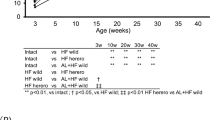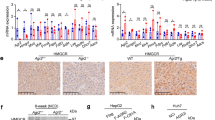Abstract
The importance of cholesterol ester synthesis by acyl CoA:cholesterol acyltransferase (ACAT) enzymes in intestinal and hepatic cholesterol metabolism has been unclear. We now demonstrate that ACAT2 is the major ACAT in mouse small intestine and liver, and suggest that ACAT2 deficiency has profound effects on cholesterol metabolism in mice fed a cholesterol-rich diet, including complete resistance to diet-induced hypercholesterolemia and cholesterol gallstone formation. The underlying mechanism involves the lack of cholesterol ester synthesis in the intestine and a resultant reduced capacity to absorb cholesterol. Our results indicate that ACAT2 has an important role in the response to dietary cholesterol, and suggest that ACAT2 inhibition may be a useful strategy for treating hypercholesterolemia or cholesterol gallstones.
This is a preview of subscription content, access via your institution
Access options
Subscribe to this journal
Receive 12 print issues and online access
$209.00 per year
only $17.42 per issue
Buy this article
- Purchase on Springer Link
- Instant access to full article PDF
Prices may be subject to local taxes which are calculated during checkout






Similar content being viewed by others
References
Bloch, K. Cholesterol: Evolution of structure and function. in Biochemistry of Lipids, Lipoproteins and Membranes (eds. Vance, D.E. & Vance, J.) 363–381 (Elsevier,–Amsterdam, 1991).
Chang, T.Y., Chang, C.C.Y. & Cheng, D. Acyl-coenzyme A:cholesterol acyltransferase. Annu. Rev. Biochem. 66, 613–638 (1997).
Goodman, D.S. Cholesterol ester metabolism. Physiol. Rev. 45, 747–839 (1965).
Chang, C.C.Y., Huh, H.Y., Cadigan, K.M. & Chang, T.Y. Molecular cloning and functional expression of human acyl-coenzyme A:cholesterol acyltransferase cDNA in mutant Chinese hamster ovary cells. J. Biol. Chem. 268, 20747–20755 (1993).
Uelmen, P.J. et al. Tissue-specific expression and cholesterol regulation of acylcoenzyme A:cholesterol acyltransferase (ACAT) in mice. Molecular cloning of mouse ACAT cDNA, chromosomal localization, and regulation of ACAT in vivo and in vitro. J. Biol. Chem. 270, 26192–26201 (1995).
Meiner, V. et al. Tissue expression studies of mouse acyl CoA:cholesterol acyltransferase gene (Acact): Findings supporting the existence of multiple cholesterol esterification enzymes in mice. J. Lipid Res. 38, 1928–1933 (1997).
Meiner, V.L. et al. Disruption of the acyl-CoA:cholesterol acyltransferase gene in mice: Evidence suggesting multiple cholesterol esterification enzymes in mammals. Proc. Natl. Acad. Sci. USA 93, 14041–14046 (1996).
Anderson, R.A. et al. Identification of a form of Acyl-CoA:cholesterol acyltransferase specific to liver and intestine in nonhuman primates. J. Biol. Chem. 273, 26747–26754 (1998).
Cases, S. et al. ACAT-2, a second mammalian acyl-CoA:cholesterol acyltransferase. Its cloning, expression, and characterization. J. Biol. Chem. 273, 26755–26764 (1998).
Oelkers, P., Behari, A., Cromley, D., Billheimer, J.T. & Sturley, S.L. Characterization of two human genes encoding acyl coenzyme A:cholesterol acyltransferase-related enzymes. J. Biol. Chem. 273, 26765–26771 (1998).
Paigen, B., Morrow, A., Brandon, C., Mitchell, D. & Holmes, P. Variation in susceptibility to atherosclerosis among inbred strains of mice. Atherosclerosis 57, 65–73 (1985).
Davis, R.A., McNeal, M.M. & Moses, R.L. Intrahepatic assembly of very low density lipoprotein. Competition by cholesterol esters for the hydrophobic core. J. Biol. Chem. 257, 2634–2640 (1982).
Wang, D.Q.-H., Lammert, F., Cohen, D.E., Paigen, B. & Carey, M.C. Cholic acid aids absorption, biliary secretion, and phase transitions of cholesterol in murine cholelithogenesis. Am. J. Physiol. 276, G751–G760 (1999).
Sehayek, E. et al. Biliary cholesterol excretion: a novel mechanism that regulates dietary cholesterol absorption. Proc. Natl. Acad. Sci. USA 95, 10194–10199 (1998).
Wilson, M.D. & Rudel, L.L. Review of cholesterol absorption with emphasis on dietary and biliary cholesterol. J. Lipid Res. 35, 943–955 (1994).
Young, S.G. et al. A genetic model for absent chylomicron formation: mice producing apolipoprotein B in the liver, but not in the intestine. J. Clin. Invest. 96, 2932–2946 (1995).
Krause, B.R. & Bocan, T.M.A. ACAT inhibitors: physiologic mechanisms for hypolipidemic and anti-atherosclerotic activities in experimental animals. in Inflammation. Mediators and Pathways (eds. Ruffolo, R.R., Jr. & Hollinger, M.A.), 173–198 (CRC Press, Boca Raton,–Florida, 1995).
Klein, R.L. & Rudel, L.L. Cholesterol absorption and transport in thoracic duct lymph lipoproteins of nonhuman primates. Effect of dietary cholesterol level. J. Lipid Res. 24, 343–356 (1983).
Dixon, J.L. & Ginsberg, H.N. Regulation of hepatic secretion of apolipoprotein B-containing lipoproteins: information obtained from cultured liver cells. J. Lipid Res. 34, 167–179 (1993).
Purcell-Huynh, D.A. et al. Genetic factors in lipoprotein metabolism. Analysis of a genetic cross between inbred mouse strains NZB/BINJ and SM/J using a complete linkage map approach. J. Clin. Invest. 96, 1845–1858 (1995).
Khanuja, B. et al. Lith1, a major gene affecting cholesterol gallstone formation among inbred strains of mice. Proc. Natl. Acad. Sci. USA 92, 7729–7733 (1995).
Machleder, D. et al. Complex genetic control of HDL levels in mice in response to an atherogenic diet. Coordinate regulation of HDL levels and bile acid metabolism. J. Clin. Invest. 99, 1406–1419 (1997).
Lammert, F., Wang, D.Q.-H., Cohen, D.E., Paigen, B. & Carey, M.C. Functional and genetic studies of biliary cholesterol secretion in inbred mice: Evidence for a primary role of sister to P-glycoprotein, the canalicular bile salt export pump in cholesterol gallstone pathogenesis. in Bile Acids and Cholestasis (eds. Paumgartner, G., Stiehl, A., Gerok, W., Keppler, D. & Leuschner, U.), 224–228 (Kluwer Academic Publishers, Dordrecht, The–Netherlands, 1999).
Smith, J.L., Hardie, I.R., Pillay, S.P. & de Jersey, J. Hepatic acyl-coenzyme A:cholesterol acyltransferase activity is decreased in patients with cholesterol gallstones. J. Lipid Res. 31, 1993–2000 (1990).
Lee, O., Chang, C.C.Y., Lee, W. & Chang, T.-Y. Immunodepletion experiments suggest that acyl-coenzyme A:cholesterol acyltransferase-1 (ACAT-1) protein plays a major catalytic role in adult human liver, adrenal gland, macrophages, and kidney, but not in intestines. J. Lipid Res. 39, 1722–1727 (1998).
Chang, C.C.Y., Lee, O., Lin, S. & Chang, T.-Y. Quantitative analysis of human acyl-coenzyme A:cholesterol acyltransferase-1 and -2 (ACAT-1 and ACAT-2) in intestines, Caco-2 cells, HepG2 cells, adult and embryonic livers by using specific antibodies. Circulation 100, I–612 (1999).
Chang, C.C.Y. et al. Immunological quantitation and localization of ACAT-1 and ACAT-2 in human liver and small intestine. J. Biol. Chem. 275, 28083–28092 (2000).
Accad, M. et al. Massive xanthomatosis and altered composition of atherosclerotic lesions in hyperlipidemic mice lacking acyl CoA:cholesterol acyltransferase 1. J. Clin. Invest. 105, 711–719 (2000).
Mortensen, R. Production of a heterozygous mutant cell line by homologous recombination (single knockout). in Current Protocols in Molecular Biology Vol. 2 (eds. Ausubel, F.M. et al.), 9.16.1–9.16.11 (John Wiley & Sons, New–York, 1999).
Farese, R.V.,Jr. et al. A novel function for apolipoprotein B: lipoprotein synthesis in the yolk sac is critical for maternal–fetal lipid transport in mice. J. Lipid Res. 37, 347–360 (1996).
Smith, J.L., Lear, S.R. & Erickson, S.K. Developmental expression of elements of hepatic cholesterol metabolism in the rat. J. Lipid Res. 36, 641–652 (1995).
Erickson, S.K., Shrewsbury, M.A., Brooks, C. & Meyer, D.J. Rat liver acyl-coenzyme A:cholesterol acyltransferase: its regulation in vivo and some of its properties in vitro. J. Lipid Res. 21, 930–941 (1980).
Horie, Y., Fazio, S., Westerlund, J.R., Weisgraber, K.H. & Rall, S.C., Jr. The functional characteristics of a human apolipoprotein E variant (cysteine at residue 142) may explain its association with dominant expression of type III hyperlipoproteinemia. J. Biol. Chem. 267, 1962–1968 (1992).
Schwarz, M., Russell, D.W., Dietschy, J.M. & Turley, S.D. Marked reduction in bile acid synthesis in cholesterol 7α-hydroxylase-deficient mice does not lead to diminished tissue cholesterol turnover or to hypercholesterolemia. J. Lipid Res. 39, 1833–1843 (1998).
Jensen, D.R. et al. Prevention of diet-induced obesity in transgenic mice overexpressing skeletal muscle lipoprotein lipase. Am. J. Physiol. 273, R683–R689 (1997).
McCormick, S.P.A. et al. Transgenic mice that overexpress mouse apolipoprotein B. Evidence that the DNA sequences controlling intestinal expression of the apolipoprotein B gene are distant from the structural gene. J. Biol. Chem. 271, 11963–11970 (1996).
Hamilton, R.L., Jr., Goerke, J., Guo, L.S.S., Williams, M.C. & Havel, R.J. Unilamellar liposomes made with the French pressure cell: A simple preparative and semiquantitative technique. J. Lipid Res. 21, 981–992 (1980).
Turley, S.D., Daggy, B.P. & Dietschy, J.M. Psyllium augments the cholesterol-lowering action of cholestyramine in hamsters by enhancing sterol loss from the liver. Gastroenterology 107, 444–452 (1994).
Acknowledgements
We thank E. Moore and B. Jefferson for technical assistance; T. Yu for blastocyst injections; B. Tow for assistance with ACAT assays; D. Newland and D. Sanan for assistance with histology; J. Carroll, J. Hull and S. Gonzales for graphics; S. Ordway and G. Howard for editorial assistance; B. Taylor for manuscript preparation; and D. Mangelsdorf and H. Chen for comments on the manuscript. This work was supported by the National Institutes of Health grants HL57170 (to R.V.F.), HL60844 (to R.L.H.), HL09610 (to John Dietschy), NIH postdoctoral fellowship training grants (to K.K.B. and M.A.), a postdoctoral fellowship from the Austrian Science Fund (to S.N.) and the J. David Gladstone Institutes.
Author information
Authors and Affiliations
Corresponding author
Rights and permissions
About this article
Cite this article
Buhman, K., Accad, M., Novak, S. et al. Resistance to diet-induced hypercholesterolemia and gallstone formation in ACAT2-deficient mice. Nat Med 6, 1341–1347 (2000). https://doi.org/10.1038/82153
Received:
Accepted:
Issue Date:
DOI: https://doi.org/10.1038/82153
This article is cited by
-
FGF15 promotes hepatic NPC1L1 degradation in lithogenic diet-fed mice
Lipids in Health and Disease (2022)
-
Contradictory roles of lipid metabolism in immune response within the tumor microenvironment
Journal of Hematology & Oncology (2021)
-
Sterol O-acyltransferase 2 chaperoned by apolipoprotein J facilitates hepatic lipid accumulation following viral and nutrient stresses
Communications Biology (2021)
-
Voluhemins, new inhibitors of sterol O-acyltransferase, produced by Volutella citrinella BF-0440
The Journal of Antibiotics (2020)
-
Mechanisms and regulation of cholesterol homeostasis
Nature Reviews Molecular Cell Biology (2020)



